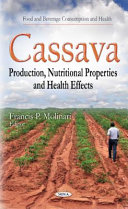Cassava production, nutritional properties and health effects
| Publisher: | Nova Science Publishers, Incorporated |
| Subject: | Cassava. |
| Authors: | Francis P. Molinari |
| Pages: | 220 pages |
| Binding: | Hardcover |
| ISBN: | 9781633210318 |
| Call No: | SB211 C343 2014 |
Cassava is the most important of the root crops in the tropics and ranks fourth after rice, sugarcane and maize as a source of calorie for human needs. Since its introduction into Africa in the 16th century, cassava has spread throughout sub-Saharan Africa to become one of the dominant starchy staples in the diet of the people. Cassava is a major staple for about half of the Nigerian population and nearly 50 million tonnes of fresh cassava is produced annually in the country. This quantity is enough to meet the calorie requirement of 50 million people at about 200 calories per day. Cassava is important not just as a subsistence or food security crop, but also as a main source of cash income for producing households. Its production and processing provide employment and income for the rural poor, especially women and children. This book discusses the environmental impact cassava may have; the functional and nutritional characterization of cassava flour; cassava bread; other food products developed from using cassava roots and its derivatives; and cassava varieties and their breeding status.

